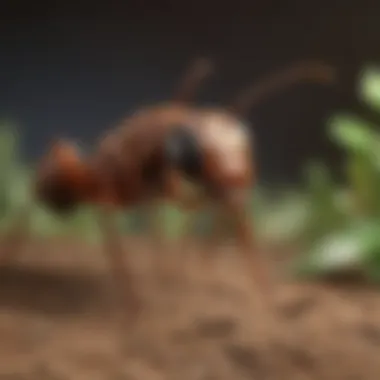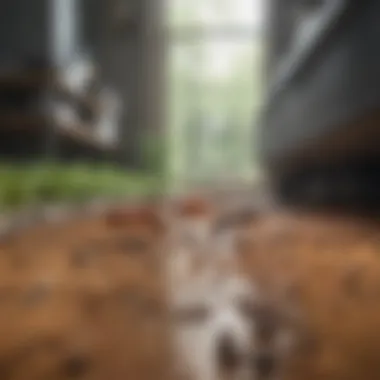Comprehensive Guide to Ant Infestations


Intro
Ant infestations in residential spaces present unique challenges for homeowners. Understanding how and why ants invade our comfort zones sheds light on effective prevention and control. In this article, we will systematically dissect the multifaceted nature of ant problems. Homeowners will benefit from a thorough examination of common ant species, their behaviors, and actionable strategies for managing populations effectively.
The Importance of This Topic
Addressing ant infestations is critical for maintaining a safe and comfortable home. Ants can compromise not only the aesthetic appeal of living spaces but can also introduce health risks due to contamination. Knowledge of ant behavior enhances the homeowner's ability to anticipate and mitigate these risks. Furthermore, sustainable pest control practices contribute to long-term solutions without environmental detriment.
Residents often find themselves puzzled by the sudden appearance of ants in their homes. Understanding the underlying causes of infestations, such as food sources and environmental conditions, is essential. Moreover, recognizing that different ant species exhibit varying behaviors will refine control methods and preventive strategies.
This article draws upon evidence and organizes information logically to empower readers. Thus, equiping homeowners with the necessary tools and insights to address ant problems effectively.
Understanding Ant Infestations
Understanding ant infestations is crucial for homeowners to mitigate the problems these pests can cause. Recognizing the underlying factors that lead to infestations helps in developing appropriate strategies to keep them at bay. Effective management begins with knowledge, and being informed about ant behavior can facilitate prevention and elimination efforts.
Ants are social insects, and they operate in colonies that can grow significantly if not addressed promptly. The presence of an ant problem can lead to more than just annoyance; it can also cause structural damage and contamination of food sources. Therefore, comprehending the causes, behaviors, and types of ants that commonly invade homes is pivotal for effective control and management.
What Leads to Ant Problems
Ant problems often stem from various environmental factors. Factors such as food availability, moisture, and shelter heavily influence their presence in residential spaces. Homes that are not properly sealed or cleaned can inadvertently offer appealing conditions for ants.
- Food Sources: Ants are attracted to food, including crumbs and spills, especially those with sugar and grease. Leaving food out can create an inviting environment.
- Moisture: Similarly, areas with moisture, like leaky pipes or damp basements, can attract certain ant species looking for hydration.
- Shelter: Cracks in walls, gaps in windows, and other structural openings provide easy access for ants to enter a home.
By recognizing these factors, homeowners can take preventative measures to reduce the risk of infestations.
The Behavioral Patterns of Ants
Understanding ant behavioral patterns is essential for determining the best approach to prevent and control infestations. Ants communicate through pheromones, which help them track food sources and signal danger. This communication can result in the rapid formation of trails leading into homes.
- Foraging: Ants typically forage for food during daylight or just after dusk. Understanding their foraging patterns can help in identifying when and where to focus cleaning efforts.
- Nesting: Ants prefer to build nests in warm, sheltered areas. Recognizing potential nesting sites around the house can prevent infestations before they start.
Overall, awareness of these patterns can help homeowners interrupt ant activities early and reduce the likelihood of larger infestations developing.
Common Ant Species in Homes
When addressing ant infestations, it is critical to identify the species involved. Different species have distinct behaviors, nesting patterns, and food preferences. Knowing these differences allows for tailored management strategies.
Carpenter Ants
Carpenter ants are significant pests due to their ability to damage wood structures. They excavate tunnels in wood to create nests, often causing considerable harm to homes. Key characteristics include their size, which can reach up to 0.5 inches, and their black or bicolored appearance. Their strong presence serves as a warning sign for structural problems in framing, ceilings, and walls. Homeowners need to address carpenter ants swiftly to prevent costly repairs.
Pharaoh Ants
Pharaoh ants are small, usually less than 0.25 inches long, with a light yellow to red coloration. They are notorious for their ability to establish multiple colony sites. This aspect makes them challenging to control, as their colonies can quickly multiply. They are also known for infesting food and spaces with high humidity, such as kitchens or bathrooms.
Pavement Ants
Pavement ants commonly reside in nests found in soil under sidewalks, driveways, or in cracks of pavement. They are small, about 0.1 to 0.2 inches long, and are often dark brown to black. Their main activity occurs during warmer months, and they are known to invade homes through small openings.
Argentine Ants
Argentine ants are a light to dark brown and can easily be recognized by their slender bodies. They often create supercolonies, which allows them to expand aggressively into new areas, including residential spaces. Their ability to cultivate aphids and other pests for honeydew can lead to further pest issues in gardens or homes.
Identifying these species and understanding their characteristics is a vital component in effectively addressing ant infestations.


Identifying an Ant Problem
In order to effectively combat ant infestations, it is crucial to correctly identify the problem in the early stages. Ants are known for their adaptability, and some species can thrive in residential spaces if the signs of their presence are not detected promptly. Homeowners need to understand the indicators of an infestation to take appropriate measures for control. Identifying these signs not only helps in realizing the extent of the problem but also aids in determining the specific species involved. Each species has unique behaviors, preferred nesting sites, and food sources, which can inform the most effective management strategies. This section focuses on the primary indicators of ant infestations and the need to differentiate between various ant species for successful eradication.
Signs of an Infestation
Understanding the signs of an ant infestation is the first step towards effective control. Residents may notice various indicators that suggest ant activity within their homes. The more knowledge a homeowner has about these signs, the easier it becomes to tackle the problem before it escalates.
Trail Patterns
Trail patterns are perhaps the most recognizable sign of an ant infestation. Ants leave behind pheromone trails that they and other members of their colony follow to locate food sources and nesting sites. The key characteristic of trail patterns is their noticeable continuity; ants will often create well-defined paths, especially when they find food.
Observing these trails can be beneficial for identifying the direction from which the ants are entering the home and where they are going. Knowing this can help in targeting potential entry points for preventive measures.
However, a unique feature of trail patterns is that they can be transient. Ants may change routes when faced with obstructions, making it sometimes challenging to track them consistently. The primary advantage of trail identification is that it provides immediate insight into the ant's behavior, allowing homeowners to intervene swiftly.
Nesting Sites
Identifying nesting sites is crucial when dealing with an ant infestation. Ants typically build nests in hidden or hard-to-reach areas, such as wall voids, under floors, or even within the garden soil. A significant characteristic of these nesting sites is that they are often located close to food and water sources, which support the colony's survival.
Recognizing nesting sites can be a popular choice among homeowners, as it allows for targeted treatment of the infestation. A unique aspect of nesting sites is that they can sometimes be identified by observing the activity levels around specific areas, particularly when conditions are favorable, such as during warmer seasons.
However, accessing these sites for treatment can present a disadvantage. Homeowners might need to engage in thorough searching or rely on professional help, especially when nests are concealed within structural elements of the home.
Food Contamination
Food contamination is another clear sign that indicates an ant problem. Ants search for food sources and can easily invade kitchens, pantries, and dining areas. The key characteristic of food contamination is the presence of ant trails and possible droppings near food items.
Encounters with food contamination make it a critical aspect to consider in this article, as it not only indicates the presence of ants but also poses health risks to residents from unsanitary conditions. A unique feature of food contamination is that it often results in damaged food items, which leads to wasted resources and unnecessary expenses.
The advantage of recognizing this sign is that it prompts immediate action to secure food and maintain hygiene, helping to reduce the attraction for ants.
Differentiating Species
Different ant species exhibit diverse behaviors and requirements. Identifying specific ant types can be critical for selecting appropriate treatment methods. For example, Carpenter ants prefer wood, while Pharaoh ants may thrive in warmer indoor spaces and often infest food items. Proper identification facilitates specialized pest control tactics, ensuring a more efficient resolution to the infestation.
Preventive Measures
Preventive measures are crucial in managing ant infestations effectively. By taking proactive steps, homeowners can significantly reduce the risk of ants invading their spaces. These measures not only help to keep your home ant-free but also contribute to a cleaner and healthier living environment. It's essential to understand that ants are often attracted to food sources and favorable nesting sites. Thus, addressing these aspects can prevent potential infestations before they occur.
Cleaning and Sanitation Practices
Kitchen Hygiene
Maintaining proper kitchen hygiene is one of the most effective ways to prevent ant infestations. A clean kitchen denies ants easy access to food sources. Regular cleaning of counters, floors, and other surfaces is essential. Notably, crumbs left on surfaces can attract ants, as they are always on the hunt for food. A key characteristic of this practice is its simplicity. Homeowners can easily adopt these habits into their daily routines.
The unique feature of kitchen hygiene is the meticulous attention to food spillage and storage. By ensuring that dishes are washed immediately and food is stored properly, the risk of attracting ants decreases. Furthermore, this approach also minimizes other household pests, thus enhancing overall home hygiene.
Sealing Food Containers
Sealing food containers properly is another fundamental aspect of preventive measures. This practice is vital in limiting the accessibility of food to ants. Containers with secure lids deter ants more effectively than loosely covered options. The key characteristic here is the method of storage. Utilizing airtight or secure lids can prevent smells and food particles from escaping.
The unique selling point of sealed food containers is their versatility and effectiveness. They come in various shapes and sizes and can be used for different types of food. On the downside, some homeowners may find the initial investment in proper containers to be a bit high, but this is minor compared to the long-term benefits of preventing infestations.
Proper Waste Management
Proper waste management practices are integral to avoiding ant problems. Keeping trash bins covered and regularly emptying them prevents attractants for ants. The essential aspect here is how waste is handled. Not only should bins be covered, but they also need to be cleaned periodically to remove any residues that may appeal to pests.


A unique feature of proper waste management is the sorting of waste. This is not just about preventing ant access but also about recycling responsibly. The advantage here is twofold—less waste can lead to fewer attractants, and it promotes sustainable living as well. However, it may require more consistent effort compared to simply tossing trash into a bin, which some may find inconvenient.
Home Maintenance Considerations
Sealing Cracks and Crevices
Sealing cracks and crevices around the home is a proactive measure to prevent ants from entering. These small openings often go unnoticed but provide perfect entry points for ants. The key characteristic of this practice is its attention to detail. Homeowners should inspect for potential entry points regularly.
The unique feature here is that sealing is not just about preventing ants; it also contributes to energy efficiency. Proper seals keep your home insulated. Although it can require some initial effort, the long-term benefits are worth it.
Landscaping Adjustments
Landscaping adjustments can play a significant role in preventing ant infestations around your property. Overgrown vegetation can provide ants with cover and pathways to your home. The key characteristic here involves maintaining a clean and tidy yard free from excessive foliage.
The unique benefit of landscaping adjustments is that they enhance the aesthetic appeal of your home. While this might require some investment in time and energy, it creates a more inviting and well-maintained property. The downside can be the initial labor involved, but the visual and preventive benefits are considerable.
Regular Inspections
Regular inspections are a vital preventive measure. Checking for signs of ants, nesting sites, or potential attractants should be part of a homeowner's routine. The key characteristic here is diligence; being proactive can halt an infestation before it begins.
The unique nature of this practice is that it fosters awareness of your living environment. By regularly checking for issues, homeowners can address them swiftly. While some may see this as an inconvenience, the benefits of early detection cannot be overstated. Keeping on top of inspections creates a sense of security and peace of mind.
Control Methods for Ants
Effective control methods for ants are crucial in addressing infestations in residential spaces. These methods empower homeowners to manage and alleviate ant problems. The goal is to reduce the population and prevent future occurrences. Both Do-It-Yourself (DIY) solutions and professional pest control services provide valuable options. This section explores these approaches, each with its own strengths and considerations.
Do-It-Yourself Solutions
Boric Acid Baits
Boric acid baits serve as a targeted solution to combat ant infestations. The primary characteristic of boric acid is its slow-acting nature, which allows ants to carry the bait back to their colonies. This characteristic contributes to its effectiveness. When ants consume the bait, they spread it to their nest, thus reaching many individuals within the colony. This method is beneficial as it minimizes the need for harsh chemicals directly in the home environment. The drawback is that it takes time to see results, which can be frustrating for those seeking immediate relief from an infestation.
Essential Oils
Essential oils have gained popularity as a natural ant control method. Oils such as peppermint and tea tree oil repel ants upon contact. These oils disrupt ant trails and signal that the area is unsafe for them. One key benefit is their non-toxic nature, making them a preferred choice for households with children or pets. However, their effectiveness can be variable, and frequent reapplication is often necessary to maintain results. Additionally, they may not eradicate existing colonies but rather prevent new ants from entering.
Diatomaceous Earth
Diatomaceous earth is another DIY solution effective against ants. This powdery substance consists of fossilized algae that damage the exoskeletons of insects. The unique property of diatomaceous earth is its abrasive texture, which leads to dehydration of ants when they come into contact with it. Homeowners appreciate its effectiveness without the use of harsh chemicals. However, diatomaceous earth’s downside lies in its dependency on dry conditions; it loses efficacy when wet, making it less reliable in humid environments.
Professional Pest Control
Assessing the Infestation
A professional pest control service's first step is assessing the infestation's severity. This assessment is critical as it determines the most effective control strategies. Professionals identify the ant species involved and the extent of the problem. A key benefit of this thorough assessment is that it aligns treatment methods with specific ant types, leading to more targeted management. The unique aspect of these assessments is their reliance on experienced technicians who can spot signs that homeowners might overlook. On the downside, engaging professional services can be more costly compared to DIY methods.
Choosing a Service
Selecting the right pest control service is paramount for effective ant management. Homeowners must consider factors like experience, customer reviews, and treatment methodologies. This choice plays a considerable role in ensuring successful results. A reputable service typically offers consultations, outlining their approach and expected outcomes. However, this process may require time and effort to research potential providers.
Expected Results and Timeframes
Understanding expected results and timeframes is essential when engaging with professional pest control. Upon initiating treatment, homeowners should be prepared for varying timelines for ant elimination. A key feature of professional services is their ability to provide estimated timeframes based on infestation levels and treatment plans. Clear communication regarding what to expect helps manage homeowner expectations. While professional methods often yield faster visible results, it is important to note that complete eradication may take multiple visits, depending on the severity of the infestation.
"Effective ant control involves a combination of proper assessment, targeted treatment, and informed expectations about results and timelines."


Environmental Considerations
Understanding the environmental factors that influence ant infestations is crucial for homeowners. Ant behavior and activity are closely linked with weather patterns and seasonal changes. By acknowledging these elements, one can effectively anticipate and address potential infestations before they escalate into larger problems.
How Weather Affects Ant Behavior
Weather conditions significantly impact the behavior of ants. For instance, during hot and dry spells, ants tend to search for moisture and food sources more aggressively. The changing temperature and humidity levels can drive ants to seek shelter in homes. In contrast, cold weather may push ants to hibernate, but if they have found a way inside, they may continue to be a nuisance.
Ants are also influenced by rainfall. After a heavy rain, ants may relocate their nests, often moving into residential spaces as natural nesting sites become flooded. Homeowners should remain vigilant during and after inclement weather, as this is often when ant activity increases.
Seasonal Patterns of Ant Activity
Ants exhibit distinct seasonal patterns in their activity.
- Spring: As temperatures warm, ants become more active. Colonies begin foraging for food, making it a critical time for homeowners to ensure their homes are protected.
- Summer: Ants are at their most active. This is the peak season for infestations, especially in warmer climates. They exploit any available resources, such as open food containers and unsealed entry points.
- Fall: During autumn, ants prepare for the colder months. They often begin to invade homes in search of warmth and sustenance.
- Winter: While many species become dormant, certain colonies may remain active indoors. The potential for infestations persists.
By monitoring these seasonal patterns, homeowners can implement preventative strategies. Ensuring that outdoor areas are well-maintained can deter ants before they enter a home. Proper drainage and landscaping adjustments can significantly reduce the likelihood of infestations.
Sustainable Practices for Ant Management
Sustainable practices for ant management are essential not only for effective pest control but also for preserving ecological balance. Ants have a complex role in our environment. Although unwanted inside homes, they contribute to soil aeration and seed dispersion. Consequently, adopting sustainable practices can result in fewer chemical treatments and reduced harm to beneficial species.
Utilizing eco-friendly approaches can provide solutions that are less harmful to both humans and the environment. This section examines various sustainable strategies that not only address current ant infestations but also work towards preventing future ones.
Eco-Friendly Approaches
Adopting eco-friendly methods for ant control is a vital aspect of sustainable practices. These approaches often involve natural repellents and biological control methods. For example, substances such as vinegar, baking soda, or essential oils can effectively deter ants without the toxicity of traditional pesticides.
Implementing these strategies can lead to a healthier living environment. Moreover, they support sustainable living practices. It is crucial for homeowners to consider these methods not only for their effectiveness but also for their minimal impact on non-target organisms. Using eco-friendly approaches can result in a safer home and contribute to larger environmental conservation efforts.
Long-Term Prevention Strategies
Integrative Pest Management
Integrative Pest Management, or IPM, stands out due to its holistic approach. This strategy combines biological, cultural, and physical methods rather than relying solely on chemical pesticides. A key characteristic of IPM is its focus on understanding pest biology and ecology. This understanding aids in implementing tactics that reduce pest problems without significant chemical use.
The unique feature of IPM is its adaptability. Since different pest species require different strategies, IPM allows for tailored solutions that can vary based on specific circumstances. This flexibility is an important advantage in addressing ant infestations while minimizing environmental impact.
One advantage of this method is its effectiveness over the long term. Homeowners who execute IPM practices can see a decrease in pest populations, creating a more sustainable living environment. However, it requires consistent monitoring and evaluation, which might be less appealing for those looking for quick fixes.
Habitat Modification
Habitat modification is another crucial strategy in sustainable ant management. This method involves altering the environment to make it less conducive for pests. A key characteristic of this approach is the emphasis on altering food sources and shelter availability for ants. Reducing clutter and ensuring proper waste management can significantly deter infestations.
The unique feature of habitat modification is its proactive nature. Instead of waiting for an infestation to occur, homeowners take steps to prevent it. This can involve sealing cracks, trimming vegetation, and keeping areas dry. Such modifications can provide lasting control against various pests, including ants.
The main advantage of habitat modification rests in its low-cost methods and effectiveness. Importantly, to some degree, it offers a layered approach to pest control, making it difficult for infestations to start at all. While it might require initial effort and awareness, the long-term benefits can outweigh these considerations.
Closure
Recap of Key Points
The primary takeaways from this article include:
- Understanding Ant Behavior: Recognizing how different species behave helps in implementing effective control strategies.
- Identification of Infestations: Being able to identify signs of pests early facilitates quicker response and minimizes damage.
- Preventive Measures: Consistent sanitation practices and home maintenance reduce the likelihood of infestations.
- Control Methods: Knowing both DIY options and when to seek professional help is essential for effective management.
- Environmental Awareness: Understanding how seasonal changes affect ant activity can aid in anticipating infestations.
- Sustainable Practices: Utilizing eco-friendly approaches ensures long-term effectiveness without harming the environment.
Encouragement for Proactive Measures
Taking proactive measures is vital in the quest to maintain a comfortable home. Homeowners should be vigilant about cleanliness and implement regular checks around their premises. Small actions like properly sealing food containers and managing waste can significantly decrease ant attraction.
Moreover, creating a barrier to entry by ensuring that all gaps and cracks in walls are sealed will hinder ants looking for a nesting site.
Investing in knowledge about ant behavior and common species offers homeowners an edge over these nuisances. Combining these strategies with the understanding that environmental factors contribute to ant activity fosters an all-around approach to long-term pest management. This mindset shift towards prevention rather than reaction is key for creating a harmonious living space free from infestations.















